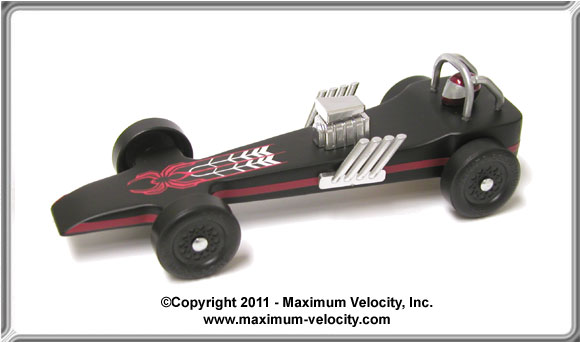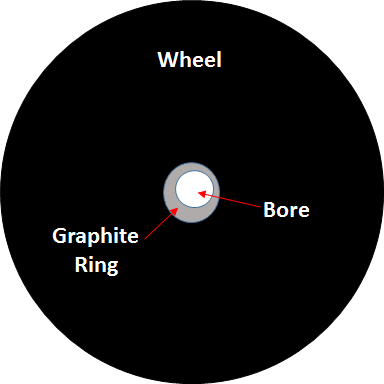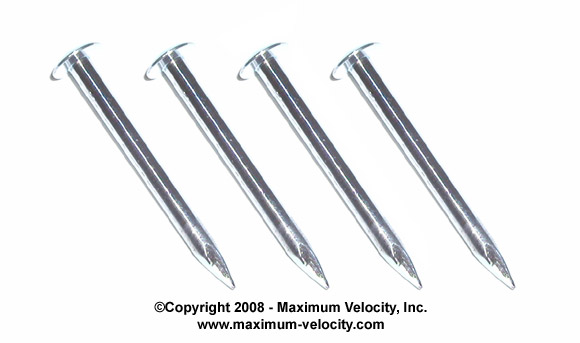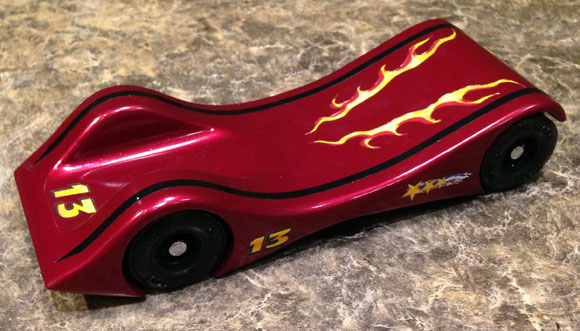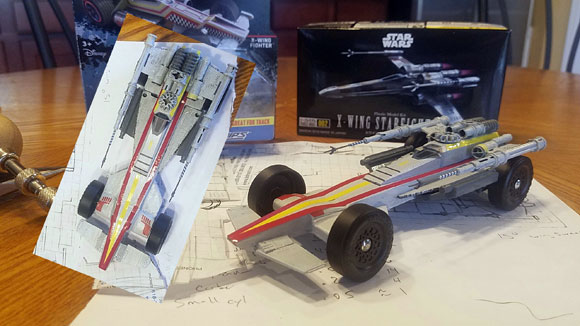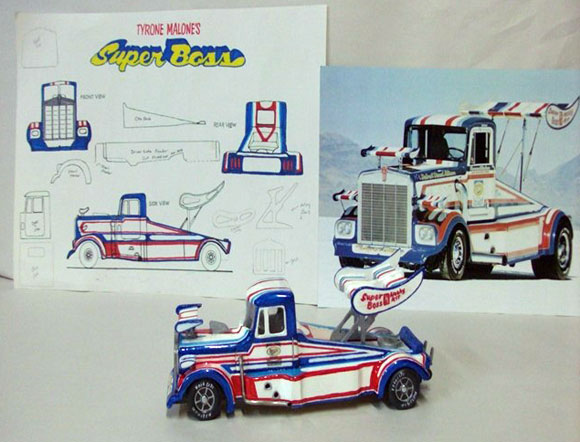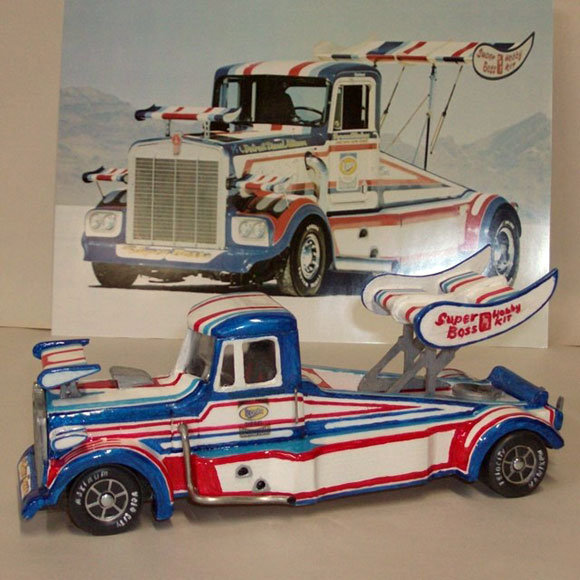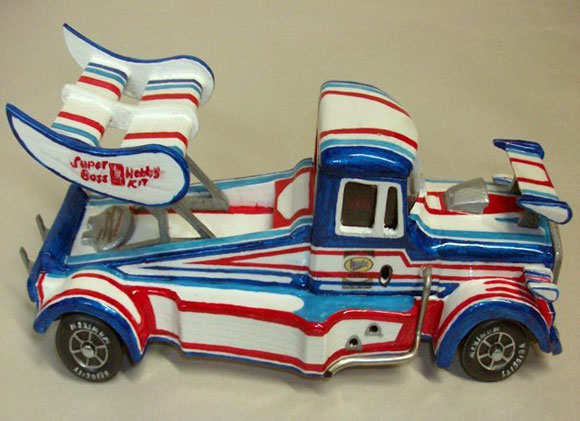PINEWOOD DERBY TIMES
Volume 16, Issue 11
February 22, 2017
In this Edition
– Editor’s Notes
– Feature Article – Lube for Performance
– Humor
– Product Showcase – BSA Speed Axles – 1 Cent
– Pinewood Derby Memory – Always Thinking Ahead
– Pinewood Derby Car Showcase
– Q&A
Editor’s Notes
New Tungsten Part

Reduced Price on Selected Parts
We have just reduced the price on our Formula One kits, and on our Tungsten Side Weight System. Both of these items are being closed out. You can find both products on our Inventory Clearance page Here.
Call for Photos
The next issue will have an extended car showcase. We have quite a few photos, but could use more. If we don’t use them in the next issue, we might use them in Volume 17.
Send us a photo of your car along with a description of any special features to: in**@**************ty.com
Please include your full name, the name of the car, and a description of the cars feature and how it performed. If selected, we will include the photo and description in this newsletter.
Photos must be sent by e-mail in JPG format (minimum size of 640×480, maximum size of 1280 x 960). Please shoot photos from the front left of the car, similar to the orientation of this car:
For better focus, keep the camera four or five feet away from the car, and then use the camera’s zoom to fill the frame with the car. Also, use a solid (preferably white) background for the photo.
Send only one photo per car, unless an additional photo is needed to adequately show a feature. Thanks.
MV Basic & Wedge Car Kits

– Quality Block – Unlike the blocks provided by some organizations, our blocks are soft, northwestern pine blocks, cut precisely to 7 inches long, 1-3/4 inches wide, and 1-1/4 inches tall. These dimensions, as well as the axle slots accurately duplicate the dimensions of standard pinewood derby blocks from BSA and PineCar.
– Simple Axle Preparation – Don’t worry about filing off flaws, or losing hub caps. Our Speed Axles have no burrs or crimp marks, and install without hub caps. With or without polishing, they are ready to go. We supply five, so you have a spare.
– Quality Wheels – Forget cheap, out of round wheels. Our MV wheels are top-quality wheels. You will not be disappointed with the quality of these wheels.
So, if your organization does not mandate a particular kit type,
consider our MV Basic Car Kits or MV Wedge Car Kits.
Can We Help?
If we can help you in any way with your pinewood derby project, or if you have any feedback regarding this newsletter, please Contact Us.
Feature Article
Lube for Performance – Getting the Most out of Graphite
By Randy Davis
Graphite seems so simple that it shouldn’t require much discussion. But surprisingly there are many factors relating to graphite that most people are not aware of. Since graphite is the most common lubricant used for pinewood derby cars, and since lubrication is one of the major keys to performance, it is of great benefit to the car builder to fully understand the ins and outs of graphite.
This article will discuss several pertinent topics relating to
graphite including:
1. What is graphite?
2. How graphite lubricates
3. Graphite quality
4. Graphite additives
5. Graphite application
6. Graphite break-in
7. Cautions:
a. Graphite with alcohol
b. Graphite packing
c. Too little graphite
d. Excess break-in
What is Graphite?
Graphite is a naturally forming, crystalline form of carbon.(1) Graphite forms into thin “flakes” that naturally slide on each other to produce a lubricating effect. Graphite is sold by “mesh” size, which determines the size of the flakes. Larger mesh sizes mean smaller flakes. A common size for pinewood derby use is between 200 and 300 mesh.
Common misperception: Graphite is the same as pencil lead.
Fact: Pencil lead is very fine graphite powder mixed with clay. Pencil lead is unsuitable for lubrication.
How Graphite Lubricates
Graphite naturally adheres to porous materials (such as pinewood derby wheels), but naturally slides on slick materials (such as polished axles). In addition, the graphite flakes slide on each other. Consider a spinning pinewood derby wheel and a fixed axle; the graphite will slide on the axle (and on other graphite flakes), and if enough graphite is present, the axle will not touch the plastic wheel.
Common misperception: Graphite needs to stick to the pinewood derby axles to work right.
Fact: Graphite sticks to the wheel bore, and builds up a coating sufficient to keep the metal axle from touching plastic throughout the race event.
Graphite Quality
Here is a common conversion I have with customers:
Me: Do you need graphite?
Customer: I have some laying around somewhere.
Me: Do you know what brand of graphite you have?
Customer: Just something I got at the hardware store?
Me: You may want to consider a higher quality graphite. Graphite sold at hardware stores is generally not of a high quality, as locks are not very demanding.
I then go on to explain that graphite is a refined product. The purity of the graphite determines the lubricity (how well it lubricates), but also affects the cost. Most inexpensive graphite brands contain 80 to 85 percent pure graphite, with the remaining percentage consisting of non-carbon impurities. A high quality graphite(2) is generally 99 percent pure. The additional purity improves the lubricity and helps its adherence to the wheel.
Common misperception: All graphite is the same.
Fact: Graphite suppliers offer a large variety of graphite qualities, and mesh sizes. These are sold for many lubricating applications. For pinewood derby use, the best graphite is a high purity, natural flake graphite.(3)
Graphite Additives (4)
Several additives are commonly blended with graphite including: talc, Molybdenum Disulfide (MS2) and Tungsten Disulfide (TS2). The purpose of these additives is to enhance the lubricating ability of graphite for specific applications.
Talc is blended with graphite for certain agricultural uses. This blend is not pertinent for pinewood derby racing.
Both MS2 and TS2 are promoted for pinewood derby racing. However, both of these additives have the drawback of increasing the abrasiveness of the graphite. After polishing axles to a high shine, the use of a graphite with MS2 or TS2 will result in scratching of the polished axle. In addition, no published test shows a performance benefit to pinewood derby cars when MS2 or TS2 is added to a high quality graphite.
Common misperception: MS2 has a lower coefficient of friction than graphite, so it must be better for pinewood derby use.
Fact: At very high pressures (weights), the above statement is true. MS2 is the preferred choice for high pressure applications. However, pinewood derby racing is a very low pressure application. At low pressures, graphite has a lower coefficient of friction than MS2.
Graphite Application
Graphite must be built up in layers on the wheel bore. This is done by repeated application of the graphite, followed by spinning the wheel on the axle.
A simple procedure for applying graphite is shown below. Please note that lubrication is performed BEFORE the wheels/axles are mounted on the car.
1. Fill the bore of the wheel with graphite.
2. Insert an axle into the wheel bore.
3. With one hand, firmly grasp the axle and hold the axle horizontal to the ground.
4. With the other hand, spin the tire gently — don’t drop the axle. Spin the wheel ten times.
5. Hold the axle with the wheel hanging towards the ground.
6. Deposit some lube into the gap between the axle and wheel bore.
7. Tap the wheel gently to help move the lube down into the wheel bore.
8. Repeat steps 3 to 7, at least two more times. Spend five minutes per wheel on these steps.
9. Finally, spin the wheel 10 times. Don’t add any more graphite after this point.
10. After performing this procedure keep the wheel/axle pairs together as a unit.
After this procedure, the bore of the wheel will have a sufficient coating of graphite to last through virtually any pinewood derby event.
Common misperception: Putting graphite in a baggie and “marinating” the wheels in the graphite will provide a thorough lube job.
Fact: This method of lubing will coat the exterior of the wheel in graphite, but will provide virtually no benefit on the track. Graphite must be layered onto the wheel bore to be beneficial.
Break-In
You may have heard people say that graphite must be broken in. This is a truism, but does not accurately reflect what is necessary. For proper lubrication a sufficient layer of graphite must be built up on the bore, and excess graphite must be layered onto, or shed from the wheel bore. If the bore coating is insufficient, then the coating will wear out during the event. If the excess graphite is present in the bore, then the car will be slow for a few heats as the excess graphite is layered onto or shed from the bore.
In the graphite application procedure above, the final ten spins will perform the necessary break-in. What you must not do is add additional graphite without thoroughly spinning the wheels. This is a common occurrence at pinewood derby races: people apply more graphite into the wheel bore just before the race, and don’t spin it in properly. This results in poor performance for a few heats.
Is it necessary to run a few test heats after lubricating? If the wheels are spun as indicated above, then test heats are not necessary for break-in. However, test heats may be valuable for checking car stability and alignment. Just don’t run more than two or three heats. If too many test heats are run, then the graphite may not last through the event.
Common misperception: To properly work in the graphite, many heats must be simulated by running the car on a track, on a treadmill, or by spinning the wheels with a Dremel buffing wheel.
Fact: It is very easy to overdo it when breaking in graphite. Hand spinning or a few test heats are sufficient. Treadmills may work, but only run the car for a few seconds (to simulate a few heats). Dremel buffing wheels spin so fast that you can easily wear through the graphite coating in just a few seconds.
Cautions
In order to speed up the graphite application process, a few methods have been proposed. Two of them, graphite slurry and graphite packing, are discussed below. With both of these methods, the outcome is generally not as successful as the application method described above.
Graphite with AlcoholWhen mixed with rubbing (isopropyl) alcohol, graphite forms a slurry that, when dry, will tend to stick to most surfaces. Many people suggest applying a graphite slurry to the bore of the wheel in order to quickly build up a thick coating (graphite ring).
The issue with this practice is that it is virtually impossible with this method to create a coating that is concentric with the bore and is of a uniform thickness. As in Figure 1, if the coating is not concentric with the bore, the wheel will appear out of round when spun, leading to poor performance.
Figure 1 – Non-concentric Graphite Ring
Graphite PackingAnother common practice is packing graphite into the bore with a special tool. Again, the intent is to rapidly create a thick graphite ring. As with the graphite slurry, with this method it is virtually impossible to create a coating that is perfectly concentric with the bore and is of a uniform thickness.
Too Little GraphiteA very common problem with graphite is applying a quick puff and then racing. This amount of graphite is not sufficient to lubricate properly, and will lead to poor performance.
Excessive Break-inAt the opposite extreme, many people build up a sufficient coating of graphite, and then proceed to wear it all away with excessive break-in. This is done by running the car on a treadmill for minutes at a time, spinning a wheel on a Dremel buffing wheel at high speeds for many seconds, excessive test runs on a track, et al. As previously described, graphite does need to be broken in, but this is done by spinning each wheel ten times, and/or running two or three heats. Any additional spinning of the wheels is not breaking in the graphite, but is breaking down the graphite.
CONCLUSION
Graphite is a very effective lube for pinewood derby racing. But for best performance, it must be properly applied and broken in. If you take your time and do a thorough lube job, you will be rewarded at the track. Good luck.
(1)So is a diamond, but a diamond has a 3-D structure, while graphite has a 2-D structure.
(2)Max-V-Lube is 99 percent pure.
(3)Natural flake graphite is not the only form of graphite, but is the type of graphite that works best for pinewood derby lubrication. Other types of graphite include: amorphous (very fine flake) graphite, lump (or vein) graphite, and synthetic graphite.
(4)See “Lubricant Testing” in Volume 8, Issue 10 for more information on MS2 and TS2.
Humor
A college student drove his ratty, raggedy old car into the mechanic’s shop, needing some repair advice for his jalopy.
The mechanic looked at it for a couple of minutes and said, “What you really need is the radiator cap solution.”
“Oh,” said the student, trying not to sound too confused, “Do you mean the radiator cap isn’t holding enough pressure?”
“That’s part of the problem,” the mechanic said. “You need to lift the radiator cap and drive another car under it. Then you can replace the radiator cap, and it should solve your problem.”
Product Showcase
One set of BSA Speed Axles for 1 Cent
Say “Goodbye” to burrs and crimp marks! These BSA Pinewood Derby Speed Axles are precision-made to replicate the official BSA nail, but without the burrs and crimp marks.
Benefits
– Accurate, round shaft to improve performance,
– No burrs and crimp marks, eliminating tedious work
– Axle head is slightly and accurately beveled to minimize contact with the outside wheel hub
– Axle head is round and centered on the axle shaft
– Shaft has a shiny plated surface. You can use the axles as is, or polish them with our Axle Polishing Kit or with our Axle Polish.
Through March 7, 2017, you can get one set of BSA Speed Axles for one cent. To take advantage of this limited time offer, add part 4094 to your shopping cart and use coupon code FEB22NL during checkout.
Pinewood Derby Car Showcase
Here are a few cars that show exceptional craftsmanship.
Flamin’ Grand Prix – Joel Bodder
This is an Awana Grand Prix car made by Joel Bodder and his dad. This is the first time we did full fenders and the car performed very well – it took first place for speed. We used Krytox 100 for lube. We get all of our supplies from Maximum Velocity. Thanks guys!
X-Wing Fighter – Michael Strunk
This car was based off of a Hot Wheels X-wing racer I saw earlier this year. I ordered a model kit for under $10 online (didn’t realize it was shipping from overseas so it barely got here in time) then decided the wings weren’t quite large enough so I used them as the front spoiler. I cut up an old computer case and circuit boards to use as the rear wings and the area around the cockpit, then added a couple of Legos to the top and on the ends of the wings. Then I pulled a couple more parts off the model to finish the guns and engines. After it was all assembled, I realized I didn’t plan for where to mount weights! I managed to drill 3 holes into the bottom behind the axle without splitting the car and put in some tungsten cylinders then covered up the mess with a chunk of a flexible self stick weight. I also had a couple of rounded tungsten plates left over from another build so I added that as well. It wound up just under 5 ounces after paint and pinstripes.
My son’s car was a little faster than mine when we held our race, but I still took 2nd in the adult division and won a design award as well.
Tyrone Malone’s Super Boss Semi Truck – Mark Robison
I first saw this truck on the web, and I knew I’d like to build the truck some day. So with some planning I was able to work up a pattern for building the truck. To my luck the pattern worked out!
The truck’s paint job was done using model paint brushes and charting tapes for masking off the lines. You may note that the wheels and axles on the truck are from your 18-wheeler line – just my way of saying thank you for supporting those of us who enjoy making Big Rigs. By the way, more photos of this build can be seen on the Derby Talk forum.
Share Your Car With Our Readers
Do you have a car you would like to “show off” to our readers? If so, send us a photo of your car along with a description of any special features to:
in**@**************ty.com
Please include your full name. If selected, we will include the photo and description in this newsletter.
Photos must be sent by e-mail in JPG format (minimum size of 640×480, maximum size of 1280 x 960). Please shoot photos from the front left of the car, similar to the orientation of this car:
For better focus, keep the camera four or five feet away from the car, and then use the camera’s zoom to fill the frame with the car. Also, use a solid (preferably white) background for the photo.
Send only one photo per car, unless an additional photo is needed to adequately show a feature. Also, only one car per subscriber per year please. Thanks.
Pinewood Derby Memory
Always Thinking Ahead
When I was a Webelos Den Leader the most anticipated event was always the pinewood derby. The Derby was run on a Friday, and the Sunday before was practice day – a day to fine tune and see how your car would perform.
One of the boys in our Den, Kyle, was the quiet shy kind, but you could tell he was always thinking about how to improve. On practice day, Kyle and his dad spent the entire 3 hours tuning and adjusting their car. It performed well, completing the runs with good times. The last thing they did as they were leaving was to buy a new car kit.
Race day came around and Kyle showed up with a totally new car. Not the greatest paint job or the sleekest design, but it looked good. One of the other boys in the Den laughed at it because of the way it looked. His car apparently had been built entirely by his dad at the auto shop where he worked.
To make a long story short. The finals came down to Kyle and two other boys. Kyle came in third. The kid with the dad-built car wasn’t even in the top ten. His mom freaked out, and started checking times and saying something like, “This is wrong; how can a car that doesn’t even look good beat my son’s car!”
Kyle had never won anything in his life and this was the biggest thing to him. Talking to his dad later I asked why they changed cars at the last minute. He told me that Kyle had used the practice session to work out the bugs, and then spent the week working on the mechanics of a new car. He wasn’t that concerned with the looks.
Always thinking ahead. Kyle now works for a major auto maker doing design work.
Gary Marquardt
Ann Arbor, Michigan
Do you Remember?
If you have a pinewood derby story that is funny, unusual, sad, heart-warming, etc., please send it to me in an e-mail. Don’t worry about literary polish. We will edit as needed before publishing.
If your story is used, you will receive a $10 coupon in May of 2017.
Q&A
Q: I bought two pinewood derby kits. One kit was a lot heavier than the other, so I weighed the two blocks of wood. One weighed 3.6 ounces and the other weighed 5.7 ounces. Which block is the best to work with and race, or does it matter since it must be 5 ounces total.
A: I would use the lighter block for two reasons:
1. It is much more difficult to cut, drill, and sand a heavier block
(the wood is harder).
2. You want the balance point of the car to be towards the back of the car. With a lighter block you will have more added weight to place at the back of the car. With the heavy block, you will not need much weight, so the balance point would be towards the center of the car. Thus, the lighter block should give better performance.
By the way, at Maximum Velocity, we do not sell blocks that are heavier than five ounces. We weigh every block and toss all blocks over five ounces.
Q: We built a 3-wheel rail-rider and checked its tracking on a treadmill. Everything looked good. The first 4 races my grandson ran were extremely fast – he set course records and topped off at 199 mph. But something happened after these 4 races – the car started to wobble from side to side going down the track. The fastest he could attain was about 194 mph. But he qualified to move on to the district race.
I’m not sure what may have happened. The axles were glued so they could not have moved. Any ideas what may have happened to cause the car to suddenly bounce down the track – and what we need to do to correct it?
A: Seems like something must have happened with the alignment. Maybe an axle got bent. Recheck the rear-wheel alignment to make sure they are staying on the axle heads going both forward and backward. Then recheck the front alignment to make sure you have enough drift – minimum 5 inches over 8 feet. You may also need to re-lube depending on the number of heats that were run.
Want Answers?
Do you have a pinewood derby-related question? If so, e-mail us your question.
We answer all questions by e-mail, but not every question will appear in the Q&A section of the newsletter.
Back Issues
Are you a new subscriber, or have you missed some of the previous newsletters? Don’t miss out; all of the issues for Volume 5 through Volume 16 are posted on our web site Here.
Newsletter Contributions
We welcome your contributions. If you would like to contribute an article, a web site review, a speed tip, or a pinewood derby memory, please e-mail us.
Subscription Information
The Pinewood Derby Times is a free e-newsletter focused on pinewood derby racing. It is published biweekly from October through March.
If you haven’t already done so, please forward this issue to your pinewood derby friends. But please don’t subscribe your friends. Let them decide for themselves. Thanks.
If this newsletter was forwarded to you, why not subscribe to receive this newsletter. There is no cost, and your e-mail address is safe, as we never sell or share our distribution list.
To subscribe, send a blank e-mail to
pi*********************@*******st.com
You will receive a confirmation e-mail. Reply to the confirmation e-mail and you will start receiving the Pinewood Derby Times with the next issue.
Randy Davis, Editor, Pinewood Derby Times
E-Mail: in**@**************ty.com
(C)2017, Maximum Velocity, Inc. All rights reserved. Please do not reprint or place this newsletter on your web site without explicit permission. However, if you like this newsletter we grant permission, and encourage you to e-mail it to a friend.
Maximum Velocity disclaims any personal loss or liability caused by utilization of any information presented in this newsletter.
The Pinewood Derby Times is not specific to, and is not affiliated with the Boy Scouts of America, YMCA, Awana, or any other organization.
(R)Maximum Velocity is a registered trademark of Maximum Velocity, Inc.
(R)Pinewood Derby and Regatta are registered trademarks of Boys Scouts of America.
(R)Awana is a trademark of Awana Clubs International.
All other names are trademarks of their respective owners.

